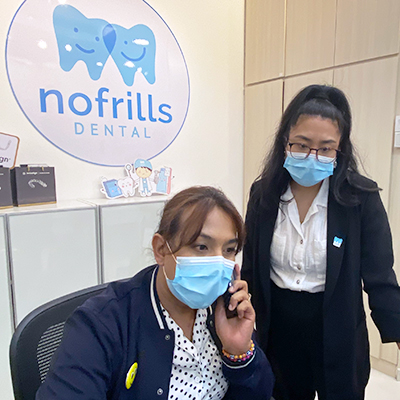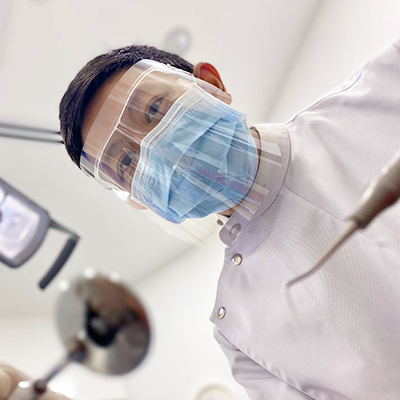Tooth Extractions
A dental extraction, also known as exodontia, is the removal of a tooth from the mouth. This procedure is usually performed when patients suffer from excessively decayed tooth that has destroyed enough tooth structure to prevent restoration, broken or cracked tooth and advanced gum disease.
Sometimes, doctors may also recommend tooth extraction during orthodontic (braces) treatment to create space to allow alignment of your teeth.
Before the tooth extraction process, our dentist will perform a dental examination. Sometimes, it may also be aided with an X-ray to allow our dentist to evaluate the internal aspects of the tooth, bone and root surrounding it. Based on the examination, the dentist will then come up with a diagnosis as to whether the teeth should be removed. The procedure may be performed under local, sedation and or general anaesthetic.
Most of the time, tooth extractions do not cause much discomfort. However, if needed, our doctor can prescribe painkillers or antibiotics.
Types Of Extractions
There are two types of extractions:
Uncomplicated Extraction
This involves the removal of teeth that are visible in the mouth. A local anaesthetic will first be administered, before using a dental forceps to loosen the tooth and finally to remove it.
Surgical Extraction
This involves the removal of teeth that cannot be easily accessed. This is a more complicated procedure that almost always requires an incision. Your doctor may recommend this if your tooth is severely broken or if it is impacted (stuck) behind bone or another tooth.
Post-Extraction Process
Rest:
Rest for a few hours following treatment and avoid strenuous exercise. Do not rinse for at least 24 hours.
Rinse:
For several days following treatment, rinse your mouth gently after meals and before bed using a mouthwash made by dissolving half a teaspoon of salt in a glass of warm water. Hold the solution in your mouth for several minutes, discard and repeat two to three times.
Food:
Avoid hot drinks, alcohol and hard or chewy foods. Choose cool drinks and soft or minced foods. Avoid direct contact with the open wound.
Bleeding:
Should slight bleeding occur, sit upright with head and shoulders raised. Apply pressure using a small pad of gauze or clean linen clamped firmly between the jaws for 15 minutes and repeat if necessary. If bleeding persists contact your clinic.
Pain:
Please take whatever pain relief you would usually take for a headache – except aspirin.
It is advisable to avoid smoking for 24 to 48 hours post treatment.
Benefits of Tooth Extractions
A dead tooth harbours bacteria and can cause localized infections within the tooth socket and surrounding bone. Dental extraction is done with the purpose to eliminate this potential threat and allow the patient to move on with its proper replacement.
Treatment Process
The dentist starts by assessing the restorability of the affected tooth. He may take an x-ray to determine the extent of tooth damage and shape of the root/s. He is also likely check with you on your intentions to replace the tooth to be extracted.
Upon your consent, he will proceed to numb the adjacent gum using a fast acting, topical anaesthetic gel. This is followed by an injection of local anaesthetic to numb the tooth. The tooth is thereafter delivered by gently loosening it using either a pair of forceps or luxator.
FAQs on Scaling & Polishing
1. How long will it take?
The procedure takes approximately 10 minutes on average and is dependent on shape of the tooth root/s and length as well as the amount of tooth structure remaining.
2. What will the experience be like?
The procedure itself is often painless as it is performed under local anesthesia. It is quite normal to be able to feel a little pressure (or pulling sensation) during tooth loosening and delivery as you are fully conscious. Your dentist will ask you to bite gently on a sterile piece of gauze to apply pressure on the extraction wound after the tooth is out.
3. What should I expect after the procedure?
You can expect minor bleeding or oozing of the extraction wound during the first few hours. This can be stopped by placing a piece of sterile gauze onto the wound and biting gently onto it to apply pressure. You can help prevent bleeding problems by avoiding hard, hot or spicy food for the next 48 hours.The local anaesthetic will usually start to wear off after 2 to 3 hours. Patients who are concerned about pain are encouraged to take painkillers right after the procedure before the local anaesthetic wears off. It is advisable not to eat while experiencing numbness as you may end up biting on yourself without knowing it.Avoid strenuous physical activity or exercise immediately after the procedure. You can resume your normal routine after 24 hours. Smokers are advised to reduce or refrain from smoking, as there is strong body of evidence that shows that smoking interferes with the normal healing.
Avoid the urge to rinse repeatedly, spit or suck on a straw for the 24 hours. Doing so may cause dislodgement of the blood clot, increasing your risk of complications. You can brush the rest of your teeth gently, avoiding the wound site for the first 2 to 3 days. Most patients will be able to resume normal brushing by the end of the 1st week.
4. Are there any risks?
As with all surgical treatment, dental extractions can result in complications. Common complications include:
Root fracture
This is usually associated with severely damaged or root canal treated teeth. Such teeth will have to be surgically removed.
Dry socket
This is a painful condition that is characterized by loss of the initial blood clot from within the tooth socket. Treatment is aimed at preventing wound infection and managing pain. Fortunately it is not very common.
Bleeding
On rare occasions, healing is complicated by delayed bleeding. This is often associated with breakdown of the initial blood clot due to an infection. Treatment is directed at promoting blood clot stability and eliminating the infection.
Bone loss
Tooth loss is almost always accompanied by bone loss at the extraction site over time. We know that the bone loss is fastest during the 1st year post-extraction. This affects your future tooth replacement options (e.g. the use of dental implants or denture support).
The best way to manage this issue is for you to discuss tooth replacement options with your dentist prior to the extraction itself. Your dentist will be in the best position to advise you on the use of bone preservation techniques or the possibility of immediate dental implant placement to help you keep a healthy bone level.
Dental Services
Book an Appointment!

CHAS & Medisave Accredited Clinics
NoFrills Dental clinics in Singapore participate in Merdeka Generation, Pioneer Generation, CHAS Card and Medisave programs.

Flexible Payment Options Available
Contact us to know more about the versatile & flexible payment options offered at NoFrills Dental clinics.

Opening Hours
Monday - Friday: 10am to 7pm
Saturday: 10am to 5pm
Sunday & Public Holiday: Closed

Book an Appointment
NoFrills Dental offers a wide variety of high-quality dental services. Talk to us to book your next dental appointment with us.

